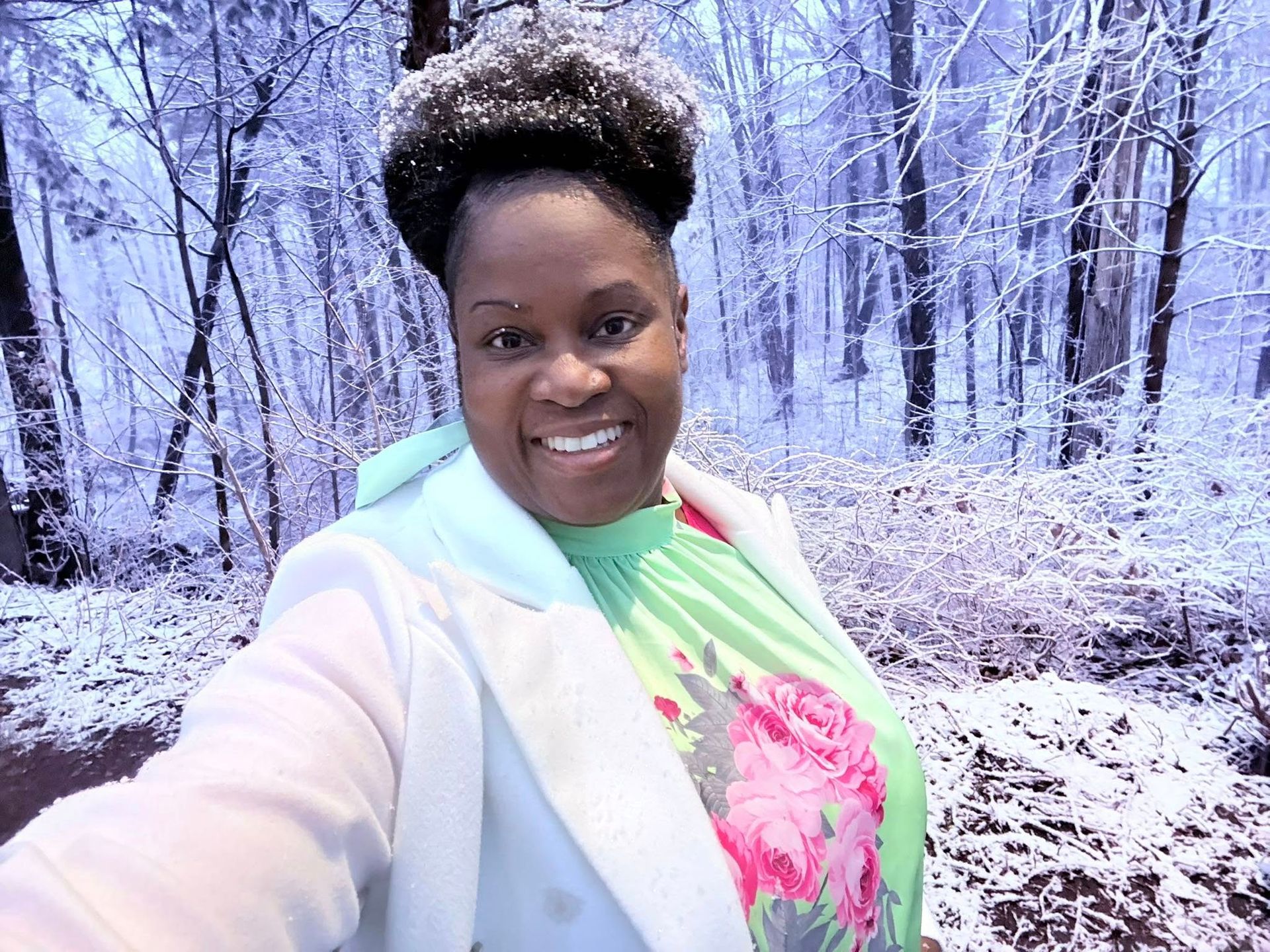Blog Layout
Helping Socially Avoidant Learners Connect with Others in the Math Classroom through Socio-Emotional Learning!
India White • July 2, 2023
Helping Socially Avoidant Learners Connect in Math through SEL!

Helping Socially Avoidant Learners Connect with Others through SEL in the Math Classroom
Sometimes, it’s easy to assume that all students are eager to approach learning math and can’t wait to enter into the classroom. However, we forget to factor in the little things including various personalities and learning styles of our students. Once we consider various traits of our learners, we will realize that math class can be a challenging environment for students who are socially avoidant. Students of this personality type might struggle to engage in class discussions, work collaboratively with peers, or seek help from their teacher. Further, they might feel like disappearing into the wall or running out of the classroom when asked to solve a math problem. However, with the right approach, you can help these students overcome their anxiety and develop social emotional skills
that will benefit them both in and out of the classroom.
Here are eight tips for helping socially avoidant students engage in math class and overcome anxiety through social emotional learning.
1. Create a Safe and Supportive Environment
The number one concern of socially avoidant students is being convinced that the learning environment is a place where they are safe and where they have control.
Hence, creating a safe and supportive environment is essential for helping socially avoidant students feel comfortable in math class. Make sure that your classroom is a welcoming space where all students feel valued and know that they are respected by others. Encourage students to share their thoughts and ideas without fear of judgment or criticism. Make sure that you use a “velvet glove” approach with these students so that they don’t retreat into their “shell” out of fear of embarrassment. They have to feel like they are “calling the shots”, or else they may shut down.
2. Use Icebreakers and Team-Building Activities
When working with socially avoidant learners, sometimes it can become socially awkward really quick, and remain that way throughout the lesson unless there’s a strategy to help break the ice. Hence, using icebreakers and team-building activities can help students get to know each other and build trust.
Once a student is able to sense that it’s okay to share out, or contribute, they will feel less threatened and will be motivated to use their student voice to contribute to the lesson. Hence, choose to use icebreaker activities at the beginning of class during bell work and throughout the school year when introducing new topics to help students feel more comfortable working with their peers.
3. Incorporate Social Emotional Learning into Math Lessons
Incorporating social emotional learning strategies into math lessons
can help students develop the skills they need to succeed in both math and social situations. Not only will it help students connect with each other; it will give them awareness on how they are coming across to others socially, in conversation and in their overall behavior. Incorporating SEL strategies will help students own their actions and contribute to responsible decision making, relationship building, social awareness and self-awareness. This will strengthen the whole child and their learning experiences. Hence, choose to teach your students how to manage their emotions, communicate effectively, and work collaboratively with others. Establishing norms for conversation during instructional delivery and mathematical discourse can assist you as you prepare the learning environment and implement SEL strategies.
4. Provide Opportunities for Individual Work
Sometimes, socially avoidant learners need a “breather”. Providing opportunities for individual work can help socially avoidant students feel more comfortable in math class. Further, independent thinking helps strengthen student's ability to think independently during math discussion. Allow your students the opportunity to work independently on assignments and provide one-on-one support when needed. Look for cues from your socially avoidant students where they signal to you that they need a break or are annoyed. Be willing to work on their terms as you continue to build trust and support for them.
5. Encourage Peer Tutoring
Encouraging peer tutoring
can help socially avoidant students build relationships with their peers and develop their math skills. Pair students with different skill levels of learners within the class and encourage them to work together to solve problems. Make sure that when pairing students for peer tutoring that you are using students who are mature and sensitive enough to scaffold and support rather than offend your socially avoidant learners. Peer tutoring will be great success once you are convinced that all students involved are comfortable working with each other and are comfortable working at the pace given. Since socially avoidant students prefer to be left alone, check on them from a distance unless they are raising their hand or signaling for more support via a raised hand or other methods.
6. Use Visual Aids and Manipulatives
Socially avoidant learners aren’t eager to share out but might not mind using manipulatives to express their thinking. Hence, using visual aids and manipulatives can help students understand math concepts and engage in class discussions.
Encourage students to use these tools to explain their thinking with their peers and share their ideas with the class in a way they are comfortable with. When presenting manipulatives or visual aids, allow the socially avoidant learner to take charge and use the tools they feel are best fit for them.
7. Provide Positive Feedback
Providing positive feedback can help socially avoidant students feel more confident in their math abilities. Acknowledge their efforts and progress and provide specific feedback on areas where they can improve. When providing positive feedback, make sure you get permission from your socially avoidant student first before drawing attention to them whole class. A great method would be to first approach them and have a side conversation with them at their desk or away from others as you inform them of your feedback. If they are comfortable, you can ask them if it would be okay to compliment them in front of their peers. If they aren’t comfortable, just provide the feedback and encourage them to keep up the great work.
8. Encourage Self-Reflection
Socially avoidant students love to self-reflect. However, sometimes they can be their worst critic. Hence, encourage your students to self-reflect but to remain optimistic
in their thoughts. Encouraging self-reflection can help students develop self-awareness and identify areas where they need to improve. Provide opportunities for students to reflect on their math skills and social emotional skills and encourage them to set goals towards improving their overall ability in your class.
Conclusion
Socially avoidant learners deserve to learn in an environment conducive for their personality and preferences. Hence, you as the educator have the power to equip your socially avoidant learner with success through these eight tips provided. As you create a safe and supportive environment, use team-building activities, incorporate SEL strategies, provide opportunities for individual work, encourage peer tutoring, use manipulatives, provide positive feedback, and encourage self-reflection, socially avoidant learners will be able to produce and perform to levels of proficiency beyond expectation.
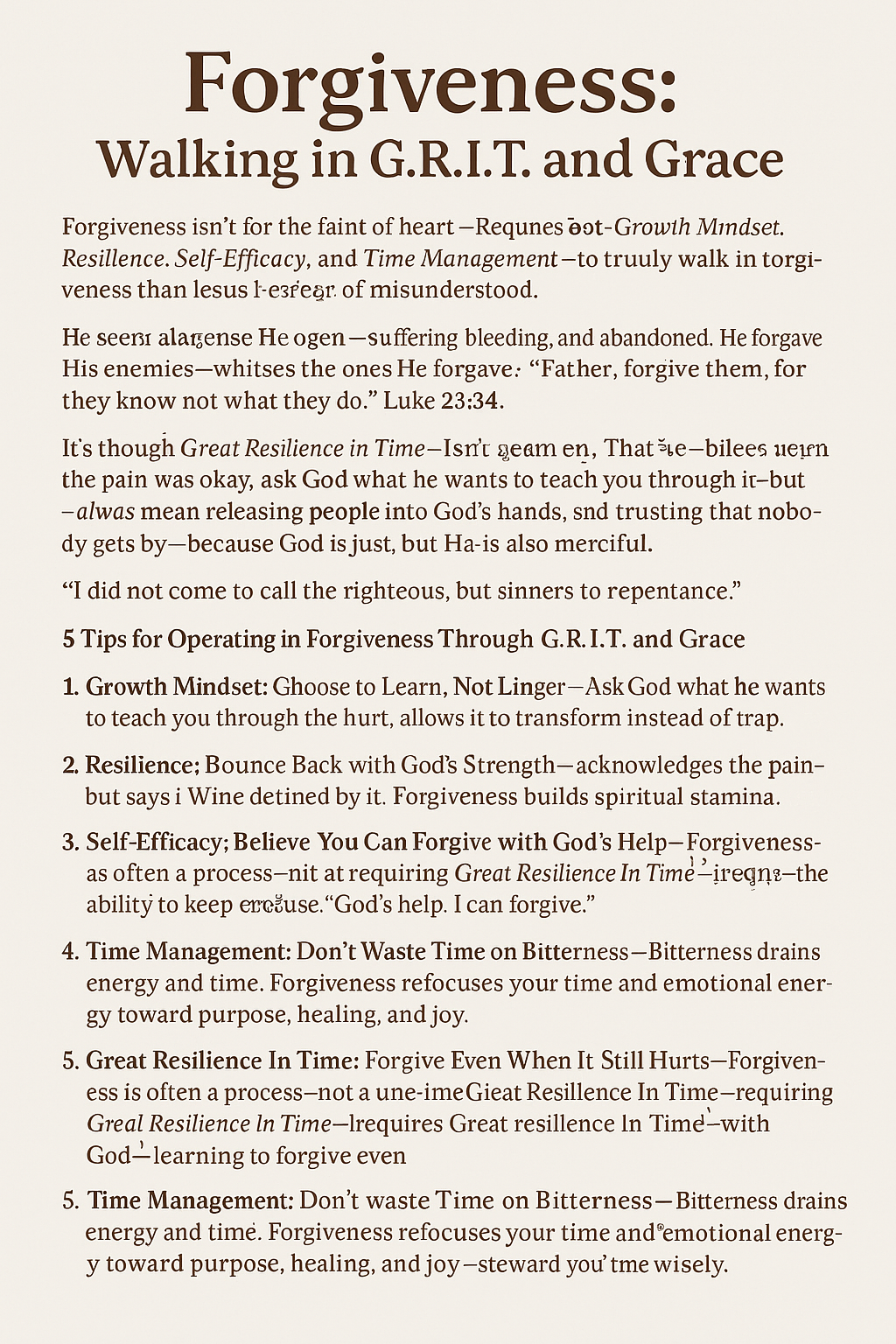
By India White
•
April 8, 2025
Forgiveness: Walking in G.R.I.T. and Grace Forgiveness isn't for the faint of heart. It takes G.R.I.T.—Growth Mindset, Resilience, Self-Efficacy, and Time Management—to truly walk in forgiveness, especially when you've been wronged, mistreated, or misunderstood. But there's no greater example of gritty forgiveness than Jesus Himself. As He hung on the cross—suffering, bleeding, and abandoned—He didn’t curse His enemies. He didn’t demand justice in that moment. Instead, He looked toward heaven and said: “Father, forgive them, for they know not what they do” (Luke 23:34). Let that sink in. The very people who had betrayed, mocked, beaten, and crucified Him were the ones He forgave. And He did it in real time, while the pain was still fresh. That’s Great Resilience In Time. And as followers of Christ, we’re called to do the same. We’re called to forgive those who have: • Abused us—physically, emotionally, or spiritually • Slandered us behind our backs • Taken advantage of our kindness • Lied to us, hurt us, or wronged us in ways words can’t capture Forgiveness doesn’t mean the pain was okay. It doesn’t mean you return to harmful situations. But it does mean we release people into God’s hands. We stop carrying the weight of bitterness. And we trust that nobody gets by—God is just, but He is also merciful. “I did not come to call the righteous, but sinners to repentance.” — Luke 5:32 God operates in mercy—not because people always deserve it, but because His heart is for restoration. And if we want God to operate in mercy toward us, we must be willing to pray that same mercy over those who have hurt us. Hence, I want to share with you 5 Tips for Operating in Forgiveness Through G.R.I.T. and Grace: 1. Growth Mindset: Choose to Learn, Not Linger Instead of replaying the pain, ask God what He wants to teach you through it. Every hurt can become holy ground if we allow it to transform us instead of trap us. Forgiveness is a chance to grow. Even when you find yourself lingering in the memories and wondering "What if?", choose to use the moments of hurt as an opportunity to heal and evolve into a greater version of you. 2. Resilience: Bounce Back with God’s Strength Resilience doesn’t mean you don’t feel the pain—it means you refuse to let it define you. Forgiveness builds spiritual stamina. Each time you choose grace, you build strength in your spirit. The enemy wanted that trial, setback, dissapointment to cause you to give up on God and yourself. However, you must believe that no weapon formed against you shall propser. Never allow Satan to take away your song or your purpose, no matter the weapon or vessel he chooses to attack you through. 3. Self-Efficacy: Believe You Can Forgive with God’s Help Forgiveness may feel impossible—but with God, you can do all things. Self-efficacy is about believing in your ability to move forward. Speak life over yourself: "With God’s help, I can forgive." This is not always an easy process but you can do it! Choose to speak positively about your situation. Tell God that you forgive them and take moments to think about what Jesus must have felt at the cross as he died for you. Sometimes, we are made to emulate the light of Christ so that others will have HOPE. That means we must be willing to be curicifed at thier hands for the Glory of God. However, be encouraged, for the Lord will restore you. 4. Time Management: Don’t Waste Time on Bitterness Bitterness drains energy and time. Let forgiveness help you refocus your time and emotional energy toward purpose, healing, and joy. Steward your time wisely—it’s too precious to spend in bondage. Take time for self-care. Cry it out, seek therapy, have an outlet that will help you develop and heal and mature in a healthy fashion. Understand that all of us fall short; people will most likely dissapoint you, so flow in grace. 5. Great Resilience In Time: Forgive Even When It Still Hurts Forgiveness is often a process, not a one-time event. It requires Great Resilience In Time —the ability to keep choosing grace, even when the pain is fresh. Jesus forgave while He was still on the cross. We, too, can learn to forgive even while healing. Through your forgiveness you'll find revelation that will bring your closer to your heavenly Father. Forgiveness is one of the greatest gifts you can give—to others, yes, but also to yourself. It frees your heart. It releases your soul. It makes space for God to heal what others tried to break. Jesus didn’t wait for an apology. He forgave in real time—with G.R.I.T. and grace. So today, let’s strive to do the same. Let’s live with: • A growth mindset that says, “God can use even this.” • Resilience that says, “I will not be broken.” • Self-efficacy that says, “I can do this with God.” • Time management that says, “I will not waste one more second holding a grudge.” Let’s walk in Great Resilience In Time and extend the same mercy we so desperately need. Because forgiveness isn’t weakness. It’s worship. So, wipe you tears, forgive, reset, start over, and thrive through G.R.I.T. and Grace. Love, India Want more? Visit www.india-white.com to schedule a meeting or book me for an event. Want a copy of the Grit Workbook for Clergy (Pastors) Click here!
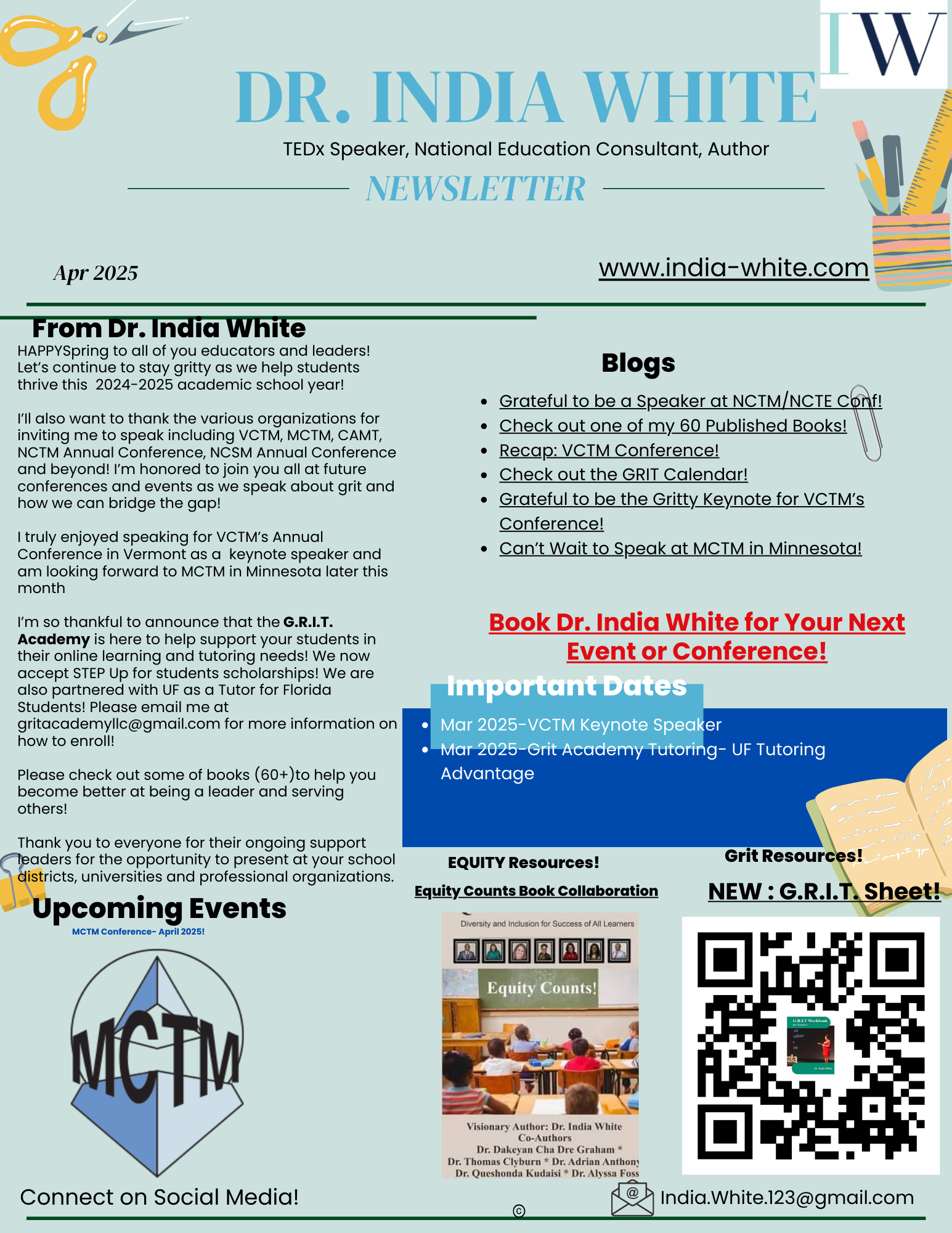
By India White
•
April 3, 2025
### April Newsletter: A Month of Grit and Growth April is here, and it’s shaping up to be an exciting month filled with powerful opportunities to build grit, inspire educators, and impact students. From conferences to new resources, I’m thrilled to share what’s happening this month and how you can get involved. Speaking at MCTM’s Annual Math Conference in Minnesota I’m honored to present at the Minnesota Council of Teachers of Mathematics Annual Conference this month, where I’ll be diving into how to create a Gritty Thinking Classroom. In this session, we’ll explore how the G.R.I.T. framework aligns with Peter Liljedahl’s Building Thinking Classrooms, helping educators develop a culture of perseverance, resilience, and self-efficacy in their math students. If you’re attending, I’d love to connect and discuss ways to empower students through productive struggle. G.R.I.T. Workbooks and Resources The G.R.I.T. Workbook series continues to grow, providing teachers, students, and parents with practical tools to develop growth mindset, resilience, and time management. Whether you’re looking to strengthen your own grit or help students push through challenges, these workbooks offer actionable strategies to build confidence and perseverance. G.R.I.T. Online Courses and Masterclass For those looking to take a deeper dive into grit, we’re rolling out G.R.I.T. online courses and mini-workshops designed to help educators and leaders implement grit-based strategies in their schools and classrooms. Stay tuned for our Masterclass, which will provide an interactive learning experience on how to cultivate grit in both personal and professional settings. G.R.I.T. Podcast: Conversations That Inspire The G.R.I.T. Podcast continues to feature insightful conversations with educators, leaders, and changemakers who are passionate about building perseverance and resilience. Each episode offers motivation and strategies to help you stay committed to your goals and push through challenges. Be sure to tune in for inspiring discussions that fuel personal and academic growth. Stay Connected If you’re looking for more ways to engage with the G.R.I.T. movement, be sure to check out: - www.india-white.com – Explore my work, speaking engagements, and resources - www.gritacademy.us – Learn about G.R.I.T. Academy, where we help students and educators develop the skills they need to thrive This month is all about embracing grit, growth, and resilience. Whether through conferences, podcasts, or online learning, I’m excited to continue this journey with you. Let’s keep pushing forward and building a culture of perseverance together. Stay gritty and keep striving for greatness!

By India White
•
April 3, 2025
Excited to Speak at MCTM’s Annual Math Conference: Building a Gritty Thinking Classroom! I can’t wait to present at MCTM’s Annual Math Conference this April in Minnesota. This opportunity is truly special because I’ll be diving into two of my passions—grit and Building Thinking Classrooms—to help educators create Gritty Thinking Classrooms that foster resilience, problem-solving, and perseverance in students. Why Grit Matters in the Math Classroom Math is not just about numbers and equations; it’s about persistence, self-efficacy, and growth mindset. So many students struggle with productive struggle, but when we intentionally build grit, they learn how to push through challenges rather than give up. By implementing Dr. India White’s G.R.I.T. framework, we help students: - Develop a growth mindset - Build resilience in problem-solving - Strengthen self-efficacy - Improve time management and perseverance Connecting Grit with Building Thinking Classrooms Peter Liljedahl’s Building Thinking Classrooms has transformed the way we engage students in math learning. When we merge BTC structures with grit, we create an environment where students: - Tackle challenging problems head-on - Collaborate with peers to build understanding - Learn to embrace struggle as part of growth - Develop confidence in their ability to succeed In my session, we’ll explore how BTC’s 14 elements align with grit and how teachers can create a culture of perseverance in their classrooms. See You in Minnesota! If you’re attending MCTM’s Annual Math Conference, I’d love to connect. Let’s talk about how to empower students to think, struggle, and grow. Together, we can build Gritty Thinking Classrooms that transform how students learn and engage with mathematics. Let’s get gritty! See you soon in Minnesota!

By India White
•
March 25, 2025
🌟 Excited to share my VCTM recap video! 🎥 Join me as I engage with teachers during my keynote, discussing strategies to best support our 8th grade math students. Together, we can make a difference! 💪📚 Check it out and let’s keep the conversation going! #drindiawhite #nctm #ncsm #vctm #vermont #nabse #naacp #education #doe
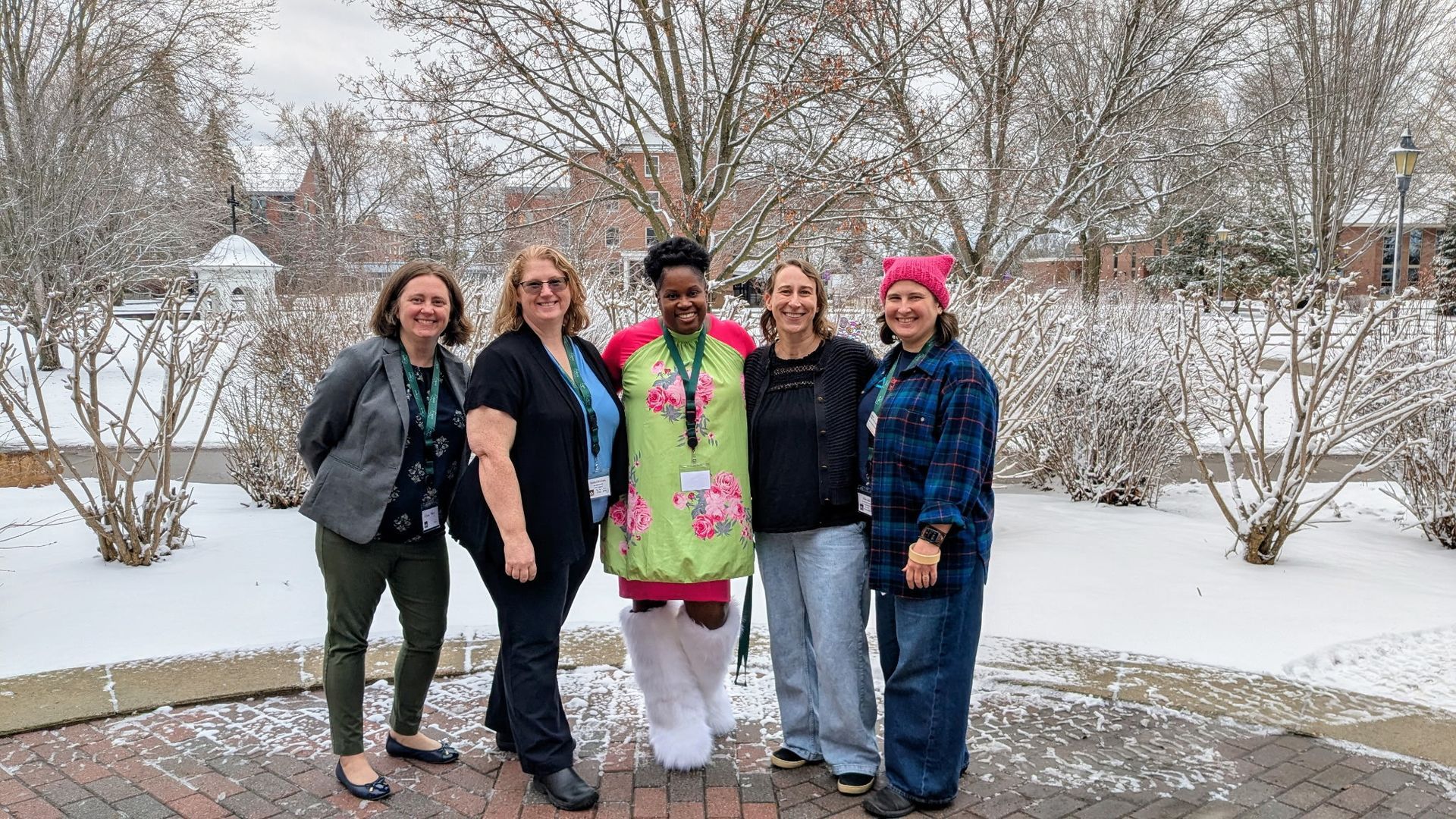
By India White
•
March 25, 2025
Reflection on The Power of Grit Keynote to Vermont Teachers Speaking to the dedicated educators of Vermont about the Power of Grit was an inspiring and reaffirming experience. As I shared the pillars of grit—Growth Mindset, Resilience, Time Management, and Self-Efficacy—it was evident that these concepts resonated deeply with the teachers in the room. Their commitment to fostering perseverance and confidence in their students was both heartening and energizing. Throughout the keynote, I emphasized the transformative role of a growth mindset—how students who embrace challenges and see effort as a path to mastery are more likely to persist through difficulties. I could see educators nodding in agreement as they reflected on their own students' struggles and triumphs. Encouraging students to reframe failure as a learning opportunity is a crucial shift that builds not just better mathematicians, writers, and thinkers but also more resilient individuals. Resilience was another cornerstone of the discussion. I shared stories and strategies to help students push past obstacles and develop the endurance needed to navigate academic and personal challenges. The engagement in the room reaffirmed that teachers, too, are models of resilience, especially in today’s educational climate. One of the most practical elements of the keynote focused on time management—helping students (and educators) break down overwhelming tasks, set realistic goals, and prioritize effectively. The response to this section showed that time management remains a crucial skill, not only for students learning to structure their studies but also for teachers juggling multiple responsibilities. Finally, we explored the power of self-efficacy, that deep-seated belief that one’s efforts lead to success. We discussed ways to cultivate this mindset in students through intentional feedback, scaffolding, and celebrating small wins. Seeing the teachers reflect on how they could implement these strategies in their classrooms was incredibly rewarding. This keynote reaffirmed my belief that grit is not just a personal trait—it’s a culture that educators can foster in their classrooms, schools, and communities. Vermont’s educators left the session with new insights, actionable strategies, and a renewed commitment to equipping students with the perseverance and confidence needed for success. I am grateful for the opportunity to share this message, and I look forward to seeing the impact of their work in cultivating grit across the state. Thanks Vermont Rockstars. Stay gritty!

By India White
•
March 25, 2025
✨ I had a phenomenal time speaking for the VCTM Rockstars in Vermont! We dove into how to reach all learners and stay motivated through grit. 💪 I can't wait to see the results from the grit assessment and framework! Stay gritty, y’all! 🌟 #drindiawhite #vctm #vermont #grit #educators #math
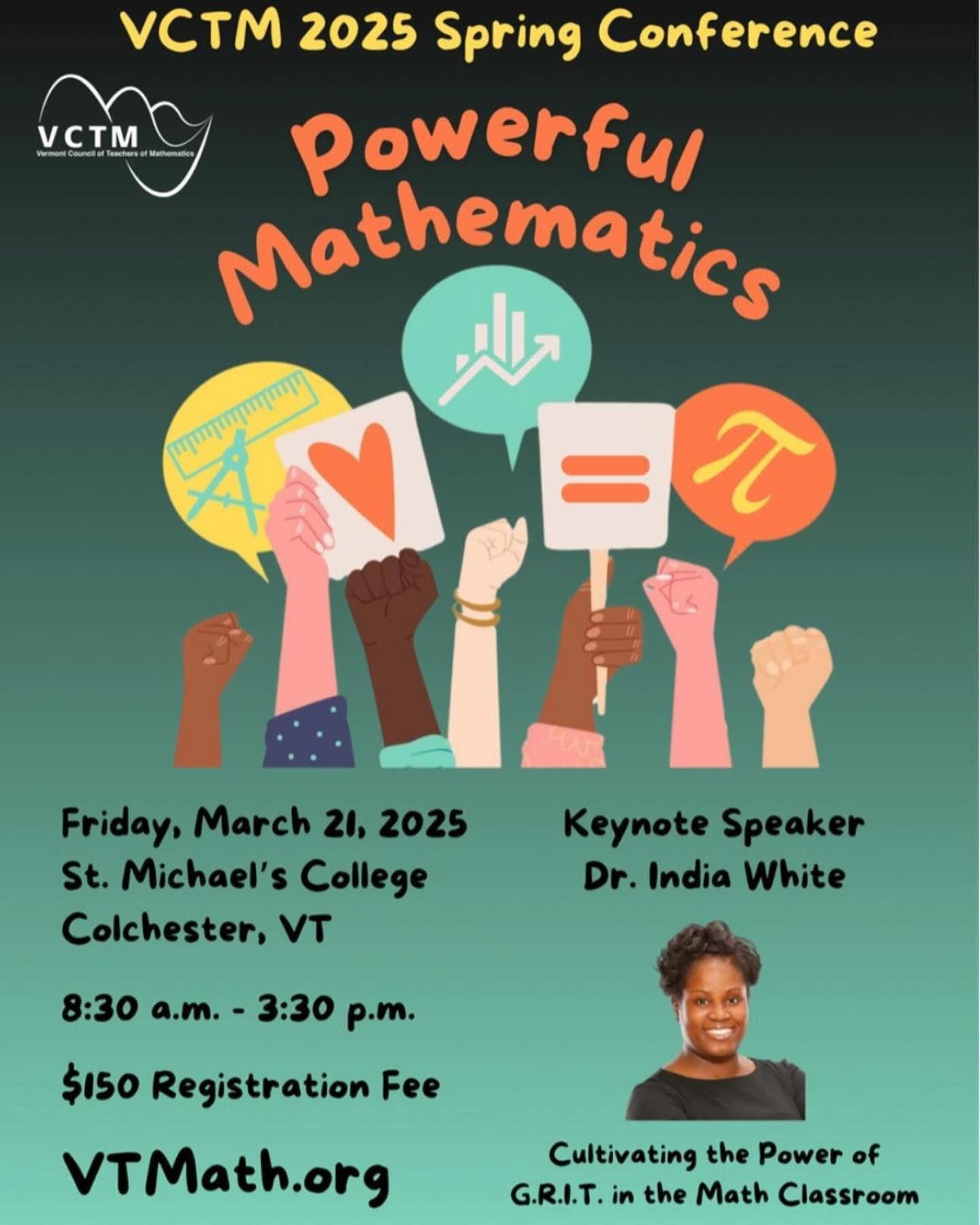
By India White
•
March 18, 2025
🌟 Super excited to announce that I’ll be the keynote speaker at the VCTM Annual Conference in beautiful Vermont! 🎉 Huge thanks to the amazing VCTM rockstars for this incredible opportunity! Let’s dive into the power of grit together! 💪✨ I can’t wait to share insights and connect with fellow educators, students, and math enthusiasts. Join us by registering below: https://vctm.wildapricot.org/event-5950535 Let’s make this an unforgettable experience! #drindiawhite #grit #tedx #vctm #teachers #students #math (I don’t own music copyright)

By India White
•
March 18, 2025
Join us on the Let's Get Gritty Podcast with Dr. India White, featuring special guest Heidi Diercks, a retired educator, and life coach! Check out Heidi's coaching nuggets here :chrome-extension://efaidnbmnnnibpcajpcglclefindmkaj/https://mail.google.com/mail/u/0?ui=2&ik=89c50e1d3a&attid=0.1&permmsgid=msg-f:1826500568311074330&th=19590896f43b0e1a&view=att&zw&disp=inline&acrobatPromotionSource=GmailNativeViewer Watch on Spotify: https://creators.spotify.com/.../Lets-Get-Gritty-Podcast... #drindiawhite #grit #tedx #lifecoach #education

By India White
•
March 18, 2025
🌟 Super grateful to announce that I’ve been selected to speak at FCTM this year! 🎉 Let’s dive into the topic of grit and its importance in education! 💪✨ Be sure to register by visiting their website. A huge thank you to the FCTM leaders for this incredible opportunity! 🙌 #DrIndiaWhite #Grit #TEDx #Math #Educators #Teachers #Students #FCTM #NCTM #NCSM
Contact Us
Thank you for contacting us.
We will get back to you as soon as possible.
We will get back to you as soon as possible.
Oops, there was an error sending your message.
Please try again later.
Please try again later.
© 2025
India White, All Rights Reserved. Powered By Automation Links
Terms of Us | Privacy Policy | About
